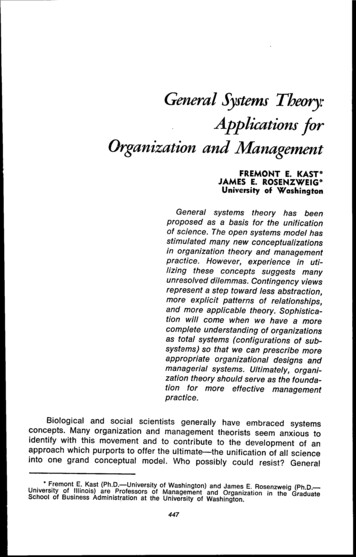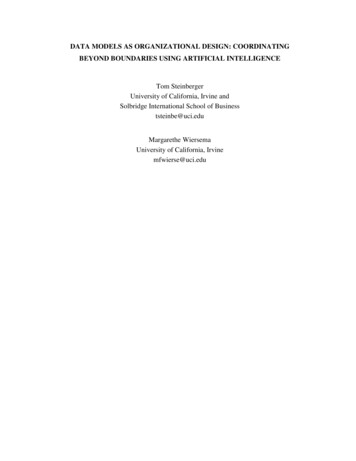
Transcription
Basic Algebra and TrigonometryMTH 102Virtual University of PakistanKnowledge beyond the boundaries
General MathematicsVUTable of ContentsLecture 1-3 . 3Lecture 4-7 . 8Lecture 8-12 . 17Lecture 13-15 . 26Lecture 16 . 29Lecture 17 . 29Lecture 18 . 29Lecture 19 - 20 . 30Lecture 21 . 33Lecture 22-24 . 35Lecture 24-30 . 39Lecture 31 . 53Lecture 32- . 53Lecture 33- . 53Lecture 34- . 53Lecture 35- . 53Lecture 36 . 54Lecture 37 . 58Lecture 38-40 . 63
VUBasic Algebra and TrigonometryLecture 1-3Sets and Numbering SystemsThe study of Mathematics begins with a study of sets and the development of the numberingsystems. Every mathematical system can be represented as a “set”; therefore, it is important for usto understand the definitions, notations and properties of “sets” Definition: A set is an unordered collection of distinct objects. Objects in the collection are calledelements of the set. Examples:oThe collection of persons living in Lahore is a set. oThe collection of all towns in the Punjab province is a set. oEach four-legged dog is an element of the set.The collection of counting numbers is a set. oEach quadruped is an element of the set.The collection of all four-legged dogs is a set. oEach town in Punjab is an element of the set.The collection of all quadrupeds is a set. oEach person living in Lahore is an element of the set.Each counting number is an element of the set.The collection of pencils in your bag is a set. Each pencil in your bag is an element of the set. Notation: Sets are usually designated with capital letters. Elements of a set are usually designatedwith lower case letters.o D is the set of all four legged dogs.o An individual dog might then be designated by d. The roster method of specifying a set consists of surrounding the collection of elements withbraces. For example the set of counting numbers from 1 to 5 would be written as{1, 2, 3, 4, 5}. Set builder notation has the general form {variable descriptive statement }.The vertical bar (in set builder notation) is always read as “such that”. Copyright Virtual University of Pakistan3
Basic Algebra and TrigonometryVUSet builder notation is frequently used when the roster method is either inappropriate orinadequate.For example, {x x 6 and x is a counting number} is the set of all counting numbers less than 6.Note this is the same set as {1,2,3,4,5}. Other Notation: If x is an element of the set A, we write this as x A. x A means x is not anelement of A.If A {3, 17, 2 } then 3 A, 17 A, 2 A and 5 A.If A { x x is a prime number } then 5 A, and 6 A. Definition: The set with no elements is called the empty set or the null set and is designated withthe symbol . Definition: The universal set is the set of all things pertinent to a given discussion and isdesignated by the symbol UFor example, when dealing with all the students enrolled at the Virtual University, the Universalset would beU {all students at the Virtual University}Some sets living in this universal set are:A {all Computer Technology students}B {first year students}C {second year students} Definition: The set A is a subset of the set B, denoted A B, if every element of A is an elementof B.If A is a subset of B and B contains elements which are not in A, then A is a proper subset of B.It is denoted by A B.If A is not a subset of B we write A B to designate that relationship. Definition: Two sets A and B are equal if A B and B A. If two sets A and B areequal we write A B to designate that relationship.In other words, two sets, A and B, are equal if they contain the same elements Definition: The intersection of two sets A and B is the set containing those elements which areelements of A and elements of B. We write A B to denote A Intersection B. Example: If A {3, 4, 6, 8} and B { 1, 2, 3, 5, 6} then A B {3, 6} Definition: The union of two sets A and B is the set containing those elements which areelements of A or elements of B. We write A B to denote A Union B. Example: If A {3, 4, 6} and B { 1, 2, 3, 5, 6} then A B {1, 2, 3, 4, 5, 6}. Algebraic Properties of Sets: Copyright Virtual University of Pakistan4
Basic Algebra and TrigonometryooVUUnion and intersection are commutative operations. In other words, A B B A andA B B AUnion and intersection are associative operations. In other words,(A B) C A (B C) and (A B) C B (A C)Union and Intersection are distributive with respect to each other. In other wordsA ( B C ) (A B) (A C) and A ( B C ) (A B) (A C) A few other elementary properties of intersection and union.A A, A , A A A, A A A.Numbering Systems: Counting numbers are called Natural numbers and the set of Natural numbers is denoted by N {1,2,3 }Integers are Natural numbers, their opposites and zero. The set of integers is denoted by Z { 3, -2, -1, 0,1,2,3 }Rational numbers such as 2/3, -31/2 0.3333, are numbers that can be written as a ratio of twointegers. The set of rational numbers is denoted by Q. This set includeso Repeating decimals, terminating decimals and fractionso Integers are also rational numbers since every integer a can be written as a fraction a/1Irrational numbers are numbers that can’t be written as fractions.o 3. 45455455545555 has a pattern but doesn’t repeat. It isn’t rational. It can’t be writtenlike a fraction.o Square root of 2, π (Pi) and e are also irrational.The Union of the set of rational numbers and the set of irrational numbers is the set of Realnumbers, denoted by RN Z Q R Definition: Cardinality refers to the number of elements in a seto A finite set has a countable number of elementso An infinite set has at least as many elements as the set of natural numbers Notation: A represents the cardinality of Set A History: Initially numbers were used for counting and the natural numbers did that job well.However there were no solutions for equations of the form x 4 0.To resolve this, the natural numbers were extended by inventing the negative integers.This was done by attaching a symbol “-” (which we now call the minus sign) to each naturalnumber and calling the new number the “negative” of the original number. This was furtherextended to all real numbers.Now people had solutions for equations of the form x 4 0, but equations of the form x2 4 0 still had no solutions. There is no real number whose square is -4.The numbering system had to be extended once again to accommodate for square roots ofnegative numbers. A symbol, 1 , was invented and it was called the “imaginary unit”. Thereal numbers were extended by attaching this imaginary unit to each number and calling it the“imaginary copy” of the real numbers. Copyright Virtual University of Pakistan5
Basic Algebra and TrigonometryVU Definition: Numbers of the form a bi are called complex numbers.o a is the real parto b is the imaginary partThe set of complex numbers is denoted by C Examples : 2 - 4i , -3 5i and -5 3/4i are all complex numbers Graphical Representation: Recall that real numbers are represented on a line. A complex numberhas a representation in a plane. Simply take the x-axis as the real numbers and y-axis as theimaginary numbers. Thus, giving the complex number a bi the representation as point P withcoordinates (a,b) as the following diagram shows: Properties of Complex Numbers:o Addition and Subtraction: For complex numbers a bi and c di,(a bi ) (c di ) (a c) (b d )i(a bi ) (c di ) (a c) (b d )iooExamples (4 6i) ( 3 7i) [4 ( 3)] [ 6 7]i 1 i (10 4i) (5 2i) (10 5) [ 4 ( 2)]i 5 2iMultiplication of Complex Numbers: For complex numbers a bi and c di,(a bi )(c di ) (ac bd ) (ad bc)i.oThe product of two complex numbers is found by multiplying as if the numbers werebinomials and using the fact that i2 1.oExample: (2 4i)(3 5i) 2(3) 2(5i ) 4i (3) 4i (5i ) 6 10i 12i 20i 2 6 2i 20( 1) 26 2i Copyright Virtual University of Pakistan6
VUBasic Algebra and Trigonometry Definition: Given a complex number z a ib, its conjugate is defined as z* a – ib Properties of conjugates:o (z*)* zo z.z* a2 b2 (real)o z z* 2a (real)o z - z* 2ib (imaginary) Division of Complex Numbers: For complex numbers a bi and c di,(a bi ) (a bi ) (c di ) x(c di ) (c di ) (c di )(ac bd ) (bc ad ) i 2c2 d 2c d2The quotient of two complex numbers is found by multiplying and dividing by the conjugate ofthe denominator. Example :3 11i 1 2i (3 11i )( 1 2i ) 3 6i 11i 22i 2 3 5i 22( 1)* 1 2i 1 2i ( 1 2i )( 1 2i )1 4( 1)1 2i 2i 4i 2 3 5i 22 25 5i 25 5i 5 i1 4555 Definition: The absolute value or modulus of a complex number is the distance the complexnumber is from the origin on the complex plane. z (a bi ) the absolute value can be found usingIf you have a complex number z a 2 b 2Example: 2 5i ( 2) 2 (5) 2 4 25 29 Copyright Virtual University of Pakistan7
VUBasic Algebra and TrigonometryLecture 4-7Functions and Quadratics Definition: A mapping between two sets A and B is simply a rule for relating elements of one setto the other. A mapping is also called a relation. Types of Relations:oOne-One Relations are mappings where each member of the pre-image is mapped toexactly one member of the image.12345 56789 oMany – Many Relations are the mappings where many members of the image areimages of more than one member of the pre-image, and members of the pre-image aremapped to more than one image. Copyright Virtual University of Pakistan8
VUBasic Algebra and baiNew YorkCyprus Has VisitedoMany - One Relations are the mappings where two or more members of the pre-imageare mapped to exactly one member of the image. Copyright Virtual University of Pakistan9
VUBasic Algebra and TrigonometryPersonBilalPeterSalmaAlaaGeorgeAzizHas A Mass ofKg 626466 oOne-Many Relations are mappings where one member of the pre-image is mapped totwo or more members of the image. Copyright Virtual University of Pakistan10
VUBasic Algebra and Trigonometrycm1430Is the length of objectPenPencilRulerNeedleStick Definition: Many-One and One-One relationships are called functions. Definition: The set consisting of members of the pre-image or inputs of a function is called itsdomain. For a given domain the set of possible outcomes or images of a function is called itsrange.o It is important to note that to define a function we need two things: One, the formula forthe function, and two, the domain.Examples:) 2 x 1 ; Domain: x R, Range: f(x) Ro f ( x o g ( x) x)o h( 1; Domain: x R – {2}, Range: g(x) Rx 2x 3 ; Domain: {x ϵ R x 3}, Range: h(x) 02o q ( x) ( x 1) 2 ; Domain: x R, Range: q(x) 2 Definition: A function is called an even function if its graph is symmetric with respect to thevertical axis, and it is called an odd function if its graph is symmetric with respect to the origin. Copyright Virtual University of Pakistan11
VUBasic Algebra and Trigonometry Theorem:oIf f(-x) f(x), then f is an even functionoIf f(-x) -f(x), then f is an odd function Example: f ( x) x 2 is an even function 3Example: f ( x) x is an odd function Definition: The sum, difference, product and quotient of the functions f and g are the functionsdefined byo(f g)(x) f(x) g(x)o(f – g)(x) f(x) – g(x)o(fg)(x) f(x)g(x)o(f/g)(x) f(x)/g(x), provided g(x) 0 Definition: Given functions f and g, then the function fog is a composite function, where g isperformed first and then f is performed on the result of g. Example: Consider 2 function s f ( x ) 3 x 2 and g ( x) x 2 . The function fog may be foundusing a flow diagram as follows:xx2squareMultiply by 33x 2f g 3x 2 2fgThus Remember, the domain of fog is the set of all real numbers x in the domain of g where g(x) is inthe domain of f.The domain of fog cannot always be determined simply by examining the final form of (fog)(x). Anynumbers that are excluded from the domain of g must also be excluded from the domain of fog. Example: Givenf ( x )and g ( x )4 x23 x find ( f g )( x) and its domain.Solution: Now Domain of f: -2 x 2 and Domain of g: x 3.( f g )( x) f ( g ( x)) f ( 3 x ) 4 ( 3 x )2 4 (3 x) 1 x1 x Copyright Virtual University of Pakistan12Add 2
Basic Algebra and TrigonometryVUEven thoughis defined for all x -1, we must restrict the domain of fog to those valuesthat are also in the domain of g. Thus, Domain fog: -1 x 3 Definition: If f is a one-one function, then the inverse of f, denoted by f-1, is the function obtainedby reversing the order of f. In other words, if f(a) b then f-1(b) a. If a function is to have an inverse which is also a function then it must be one-one. This meansthat a horizontal line will never cut the graph more than once; i.e. we cannot have f(a) f(b) if a b. Two different inputs (x values) are not allowed to give the same output (y value). Example: f(x) x2 with domain x ℜ is not one to one. So, for example, the inverse of 4 wouldhave two possibilities: -2 or 2. This means that the inverse is not a function. We say that theinverse function of f does not exist. However, if the Domain is restricted to x 0, then thefunction would be one to one and its inverse would be f-1(x) x , x 0 Properties of Inverse Functions:o Domain of the inverse is equal to the Range of f.o Range of inverse is equal to the Domain of f. Steps for finding inverse of a function f:o Find the domain of f and verify that f is one-to-one. If f is not one-to-one, then stop as theinverse does not exist.o Solve the equation y f(x) for x. i.e. make x the subject.o Interchange x and y in step two. This will give the inverse function in terms of x.o Find the domain of the inverse function.o Check that the inverse function is correct. Example: Find the inverse of the function y f(x) (x-2)2 3 , x 2. Sketch the graphs of y f(x) and y f-1(x) on the same axes showing the relationship between them.Solutiono Step 1: In order for the function to be one to one, we must restrict its domain to x 2.The Range of f is y 3 and so the domain of f-1 will be x 3.o Step 2: Make x the subject. y – 3 (x-2)2 (y –3) x-2 x 2 (y –3)o Step 3: Interchange x and y in the above equation to get y 2 (x –3). So FinalAnswer is: f-1(x) 2 (x –3) , x 3o Step 4: Verification: f[f-1(x)] f[2 (x –3)] {[2 (x –3)] -2}2 3 [ (x –3)] 2 3 (x –3) 3 x. And f-1[f(x)] f-1[(x-2)2 3] 2 ([(x-2)2 3] –3) 2 (x-2)2 2 (x-2) xGraph: Reflect in y x to get the graph of the inverse function. Copyright Virtual University of Pakistan13
Basic Algebra and Trigonometry VUDefinition: A function of the type y ax2 bx c where a, b, and c are called the coefficients, iscalled a quadratic function.The graph of a quadratic function will form a parabola. Each graph will have either a maximumor minimum point. There is a line of symmetry which will divide the graph into two halves.What happens if we change the value of a and c? When a is positive, the graph concaves downward. When a is negative, the graph concaves upward. When c is positive, the graph moves c units up.When c is negative, the graph moves c units down Solving Quadratic Equations: Since y ax2 bx c, by setting y 0 we set up a quadratic equation.To find the solutions means we need to find the x-intercept. Since the graph is a parabola, there willbe at most two solutions. Graphing Method: In this method, we use a scientific calculator and graph the equation. Then weread the x-intercepts from the graph. ooExample: x2 - 2x 0To solve the equation, write y x2 - 2x into your graphing calculator. Find the xintercepts. The two solutions are x 0 and x 2. Copyright Virtual University of Pakistan14
Basic Algebra and TrigonometryVU2y x -2x Factorization Method: To solve a quadratic equation we get it in the standard form y ax2 bx c and see if it will factorize.2o Example: x 05x 6 x2 5x 6 0 ( x 3)( x 2 ) x 3 0 or x 2 0 x 3 and x 2 Completing the Square Method: For this method we need the coefficient of x2 to be 1. We thendivide the take the coefficient of x and add and subtract the square of half of the coefficient of xfrom the equation to form a perfect square on one side of the equation.20. . This does not factorize. So we will use the completing theo Example: x 6 x 3 square method here.x 22 6 x .3The coefficient of x is 6. So, the square of 6/2 is 9.x 6 x 9 3 9 . We added 9 to both sides of the equationx2 6 x 9 6 . The left side becomes a perfect square.( x 3)2 6 x 3 6 x 3 6x 3 6 0.55 And x 3 6 5.45 Formula Method: Using the completing the square method, we get the general quadratic20, the quadratic formula is:formula. Given ax bx c x b b 2 4ac2a Copyright Virtual University of Pakistan15
Basic Algebra and TrigonometryoVU0Example: x 2 6 x 3 Here, a 1, b 6 and c 3. So, using the formula, we get: b b 2 4ac 6 62 4(1)(3) 6 24 3 6x 2a2(1)2 Note that the expression b2 – 4ac under the square root – called the discriminant determines how many solutions (if any) the quadratic equation will have.2o If b 4ac 0, there will be two distinct real solutions.o If b 2 4ac 0, there will be exactly one real solution.o If b 2 4ac 0, , there will be no real solutions. Examples: In each of the following cases determine if the equations has one, two or zero realsolutions.o 2x2 7 x 4 0b 2 4ac 7 2 4(2)(4) 49 32 17 0Therefore, there are two distinct real solutionso2x2 4x 2 0b 2 4ac 42 4(2)(2) 16 16 0Therefore, there is exactly one real solutiono3x 2 4 x 2 0b 2 4ac 42 4(3)(2) 16 24 8 0Therefore, there are no real solutions. Copyright Virtual University of Pakistan16
VUBasic Algebra and TrigonometryLecture 8-12Matrices and Determinants Definition: A matrix is a rectangular arrangement of numbers in rows and columns. Theorder of a matrix is the number of the rows and columns. The entries are the numbers in thematrix. Notation: A matrix A is written as follows: a11 a12 . a1n a a . a 21 222n A . . . . am1 am 2 . amn (a )ijwhere ars represents the entry in the rth row and sth column. A matrix with m rows and ncolumns is said to have order m x n. Operations on Matrices:ooAddition of Matrices: To add two matrices, they must have the same order. To add,we simply add corresponding entries.Example: 5 3 2 1 5 ( 2) 3 1 3 3 4 3 0 3 34 0 0 0 7 4 3 0 47 ( 3) 4oo 2 4 4 Subtraction of Matrices: To subtract two matrices, they must have the same order.We simply subtract corresponding entries.Example:07 9 4 2 0 9 2 4 4 5 06 15 4 5 10 5 138 2 32 1 ( 2)3 3 5 2 3 4 5Copyright10 Virtual University of Pakistan 306 4 7 6 ( 4) 8 2 17
VUBasic Algebra and TrigonometryooMultiplication by a Scalar: In matrix algebra, a real number is often called a scalar.To multiply a matrix by a scalar, we multiply each entry in the matrix by that scalar.Example: 24 4o0 4( 2) 4(0) 8 0 1 4(4) 4( 1) 16 4 Matrix Multiplication: Given an r x c matrix A and an s x d matrix B, we can multiplyA with B to form the matrix AB if c s. The resulting matrix will have dimension r xd.To multiply two matrices, we multiply each row in the first matrix by each column inthe second matrix. An example is shown below: a a A 11 12 a21 a22 b11 b12 b13 B b21 b22 b23 , ,We can multiply to form the matrix C AB since the number of columns of A isequal to the number of rows of B. The multiplication is carried out as follows: a11b11 a12b21 a11b12 a12b22 a11b13 a12b23 C AB a21b11 a22b21 a21b12 a22b22 a21b13 a22b23 oExample: 2 3 1 1 1 A 1 1 and B 1 0 2 1 0 (2)(1) (3)(1) 5 (2)(1) (3)(0) 2 (2)(1) (3)(2) 8 5 2 8 C AB 2 (1)(1) (1)(0) 1 (1)(1) (1)(2) 3 2 1 3 (1)(1) (1)(1) (1)(1) (0)(1) 1 (1)(1) (0)(0) 1 (1)(1) (0)(2) 1 1 1 1 Definition: A Square matrix with ones on the diagonal and zeros elsewhere is called anidentity matrix. It is denoted by I. Example: The 4 x 4 identity matrix is: 1 0I 0 0 010000100 0 0 1 Definition: Given a square matrix B, if there exists a matrix D such that BD DB I, then Dis called the inverse of B, and is denoted by D B-1. Copyright Virtual University of Pakistan18
VUBasic Algebra and Trigonometryn Given a system of equations a x bij ji, it can be written as a matrix equation Ax b ,j 1where A is the matrix of the coefficients, 𝑥 is the column matrix of the variables and 𝑏 is thecolumn matrix of the constants. i.e.𝑏1𝑏2, 𝑏 , 𝑏𝑚𝑥1𝑥2𝑥 𝑥𝑛 a11 a12 . a1n a a . a 2n A 21 22 . . . . am1 am 2 . amn If A-1 exists then the system has a unique solution given by x A 1 b Definition: A matrix is in echelon form if it has the following propertieso Every non-zero row begins with a 1 (called a leading 1)o Every leading one in a lower row is further to the right of the leading one above it.o If there are zero rows, they are at the end of the matrixA matrix is in reduced echelon form if in addition to the above three properties it also hasthe following property:o Every other entry in a column containing a leading one is zero Methods for finding Solutions of Equations:o Using Row Operations: Recall that when we are solving simultaneous equations, thesystem of equations remains unchanged if we perform the following operations: Multiply an equation by a non-zero constantAdd a multiple of one equation to another equationInterchange two equations.We have seen that any system of equations can be written as a matrix system. i.e. thetwo systems are equivalent.So, given a system Ax b we can form the augmented matrix (Ab) by attaching anadditional column at the end of the matrix A with entries from matrix b. Since theoriginal system of equations remains unchanged as described above, the systemdescribed by the augmented matrix (Ab) also remains unchanged under the followingrow operations: Multiply a row by a non-zero constantAdd a multiple of one row to another rowInterchange two rows.Using row operations, we will change the matrix (Ab) to an Echelon form or areduced Echelon form. Once that is achieved, the solution will be easily found.Example: Solve the following system of equations:x 2y z 12x 2 y 23x 5 y 4 z 1 Copyright Virtual University of Pakistan19
VUBasic Algebra and TrigonometrySolution: The system can be written in matrix form as: 1 2 1 x 1 2 2 0 y 2 3 5 4 z 1 The augmented matrix is( Ab) 1 0 0 R2R1 3 R3 R2 R3 1 2 321 22 1 1 R 2 R212 0 2 R 3 R5 4 1 3 11 1 R 2 R 112 1 2 0R 2 R 2 0 3 2 0 1 0 00102 1 1 R 123 2 2 0 0 1 1 2 03 3 R /4 1 03 1 2 0 1 0 0 4 4 2 1 1 1 1 2 2 2 0 3 3 1 2 1 1 1 0 0 0 0 1 0 1 0 0 1 1 This gives the solution: x 0, y 1, z -1oSolving Equations using Inverse: If we could find A-1, we could also solve the system 1by using x A b. One way to find inverse is as follows:oTheorem: Given a nxn matrix A, if the augmented matrix (AI), where I is the nxnidentity matrix, can be row reduced to a matrix (IB), then B is the inverse of A. If (AI)cannot be reduced to (IB), then A does not have an inverse.oExample: Solve the system of equations:2x 2 y 2z 12y z 12x 3y 1Solution: The matrix A of the coefficients is 2 2 2 0 2 1 2 3 0 To find A-1 we use the above theorem Copyright Virtual University of Pakistan20
VUBasic Algebra and Trigonometry 2 2 2 1 0 0 R R 2 2 2 1 0 0 2 1 0 1 0 3 1 0 2 1 0 1( AI ) 2 3 0 0 0 1 0 5 2 1 0 1 1 1 1 1 1 1 10 0 022R1 /2 R2 2 R3 0 5 2 1 0 1 0 1 0 1 2 R23 1 0 2 1 0 1 0 0 2 1 00 0 1 0 1 0 1 0 0 3 1 0 1 13 1 2 1 22R1 R2 R1 R3 010121010121 R3 2 R2 R3 5 2 0 0 1 2 5 2 0 0 1 2 So, 33 1 2 A 1 1 2 1 2 5 2 This gives the solution x x y A 1 b z 33 1 1 3 3 1 2 2 1 2 1 1 1 2 1 252 1 2 5 2 11 2 4 9 Definition: Let M be the set of all square matrices. Then the Determinant is a function from M tothe set of real numbers. i.e. the determinant is a process of attaching a real number to everysquare matrix. Notation: If A is a square matrix, then determinant of A is denoted by detA or A 1 21 2Example: det 3 43 4Second Order Determinant: A 2 x 2 determinant can be found using the following method:a11 a12 a11a22 a21a22a21 a22 Copyright Virtual University of Pakistan21
VUBasic Algebra and Trigonometry 1 2 ( 1)( 4) ( 3)(2) 4 6 10 3 4 Example: Definition: The Minor of an element in a third-order determinant is a second-order determinantobtained by deleting the row and column that contains the element. a11Example: Given a21a31a12a22a32a13a23a33The Minor of a23 a11a31a12a32The Minor of a32 a11a21a13a23 i jDefinition: The Cofactor of aij ( 1) (Minor of aij ) The cofactor of aij is denoted by Cij Thus, the cofactor of an element is nothing more than a signed minor. a11Example: Given a21a31a12a22a32a13a23a33a11a31a12aa 11 12a32a31 a32The Cofactor of a23 C23 ( 1) 2 3a22a32a23a22 a23 a33a32 a33The Cofactor of a11 C11 ( 1)1 1 Theorem: The value of a determinant of order 3 is the sum of three products obtained bymultiplying each element of any one row (or each element of any one column) by its cofactors. Note: The above theorem and definitions of minor and cofactor generalize completely fordeterminants of order higher than 3 2 2 02Example: Evaluate 3 11 3 1 Copyright Virtual University of Pakistan22
VUBasic Algebra and TrigonometrySolution: We expand by the first row to get:2 2 3 1102 3 1 1 2 2 1 1 2 31 1 32 ( 1)1 1 ( 2) ( 1) (0) ( 1) 3 1 1 1 1 3 (2)(1)[(1)( 1) ( 3)(2)] ( 2)( 1)[( 3)( 1) (1)(2)] 0 (2)(5) (2)(1) 12 Finding Inverse Using Determinants Definition: Given a matrix A, the transpose of A denoted AT is the matrix obtained byinterchanging the rows of A with its columns. 8 1 3 0 2 is AT Example: The transpose of A 0 10 4 3 Definition: Given a matrix A, calculate all the cofactors of A. We then form the matrix (Cij ) of 8 1 300210 4 3 the cofactors. The Adjoint or Adjugate of A is the transpose of the matrix of the cofactors. i.e.T( A) (C(C ji )adj ij )1adj ( A) A 1The inverse of A is then found by the formula: A Example: Find the inverse of the following matrix using determinant. 2 1 3 A 0 1 1 1 2 0 Solution: We need to first find all the cofactors. 1 10 10 1C12 ( 1)1 21C13 ( 1)1 3 1C11 ( 1)1 1 2 2 01 01 21 3 2 3 2 1C21 ( 1) 2 16C22 ( 1) 2 2 3 C23 ( 1) 2 3 5 2 01 01 2 2 3 2 11 3C33 ( 1)3 3 2C32 ( 1)3 2 2C31 ( 1)3 1 4010 1 1 1 Copyright Virtual University of Pakistan23
VUBasic Algebra and Trigonometry C11 C12Now, adj ( A) C21 C22 C31 C32 21TC13 C 23 C33 C11 C 12 C13C21 C31 2 6C22 C32 1 3C23 C33 1 53 1 10 10 1 1 1 2 1 3 2( 2)
Definition: A set is an unordered collection of distinct objects. Objects in the collection are called elements of the set. Examples: o The collection of persons living in Lahore is a set. Each person living in Lahore is an element of the set.











